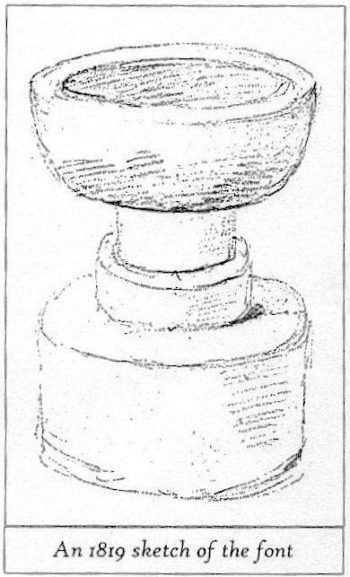 The earliest specific record of the font is a pencil drawing of 1819, which notes that the bowl is lead.[1] It has not changed in appearance since then. The font is covered with three separate pieces of lead sheet joined by seams – one flat on the bottom inside with the drain pipe in the centre; another around the inside walls turning over on the top rim; and a third around the outside, hammered into the chamfered shape of the underside. Many porous stone fonts had inside linings of lead on the bottom and sides, but to cover the outside with lead as well seems to be almost unique and require explanation. There seem to be two possible reasons – to conceal either decoration or damage.
The earliest specific record of the font is a pencil drawing of 1819, which notes that the bowl is lead.[1] It has not changed in appearance since then. The font is covered with three separate pieces of lead sheet joined by seams – one flat on the bottom inside with the drain pipe in the centre; another around the inside walls turning over on the top rim; and a third around the outside, hammered into the chamfered shape of the underside. Many porous stone fonts had inside linings of lead on the bottom and sides, but to cover the outside with lead as well seems to be almost unique and require explanation. There seem to be two possible reasons – to conceal either decoration or damage.
Fonts were at considerable risk from Puritan zealots at the Reformation, who saw them as symbols of Popish superstition and preferred a simple basin. They believed that ‘a child could just as well be christened in a tubb of water at home or in a ditch by the way, as in a founte stone in the church’[2] So many fonts were being damaged or removed that, in 1561, Queen Elizabeth issued a Royal Order requiring that ‘the Font be not removed from the accustomed place: And that in parish churches the curates take not upon them to confer Baptism in basins but in the Font customably used.’[3]
Many parishes defied this royal order but the simpler and plainer a font, the more likely it was to survive. Penn’s font is far plainer than most anyway, but it just may have decorative carving around the outside which needed to be concealed. Elsewhere, such carving was sometimes plastered over for the same reason. There is a mildly encouraging hollow ring when the lead is tapped.
Alternatively, and perhaps more probably, the lead might conceal damage done to the font, either accidentally but more likely deliberately. There is some denting in two places around the underside of the bowl; the Purbeck marble stem and base have been cemented together at some stage; and the circular stone platform has been badly damaged. We have no record of when all this damage happened, whether on one or several occasions. It could have been the result of one of the several moves. The 1899 photograph shows that the stone platform had already been damaged and it could have been further damaged in the most recent move from the south door to the west door in the 1950s. However, the damage is also consistent with a violent attack on the font at the Reformation or a century later during the Civil War and Commonwealth.
[1] BM Add 36359, f18
[2] J.G.Davies, op. cit., p.94
[3] Ibid., p.96
© Miles Green. January 2004.
